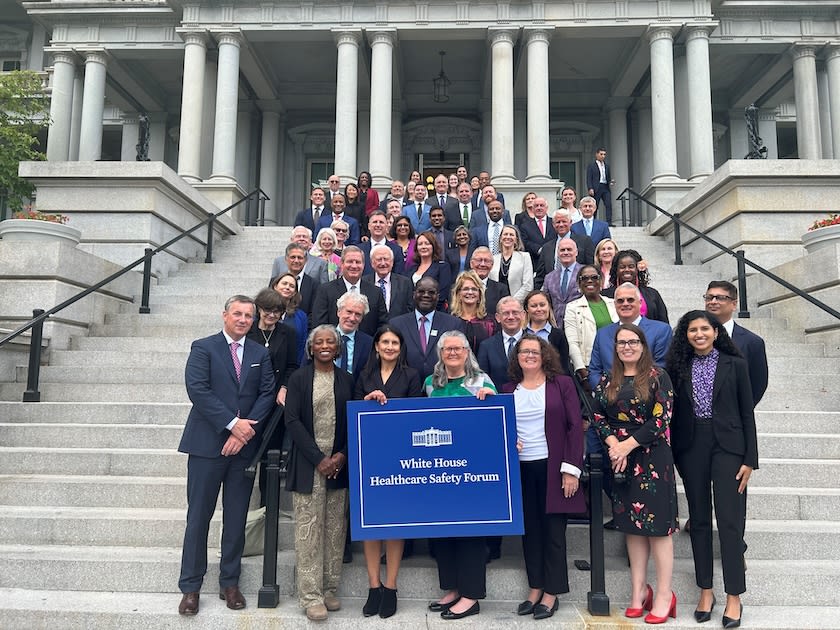Press Ganey joins leading organizations in White House commitment to healthcare safety
September 17 marked the 6th annual World Patient Safety Day—a day organized by the World Patients Alliance that calls for global unity and action in promoting overall patient and workforce safety.
The theme for 2024 focused on improving diagnosis for patient safety, with an accompanying slogan, “Get it right, make it safe!” recognizing the essential role of accurate and timely diagnoses in ensuring harm reduction.
On the 17th, I was honored to join policymakers, healthcare providers, and corporate and nonprofit health leaders from across the country in Washington, D.C., for the 2024 White House Healthcare Safety Forum.

The forum served as a platform for discussion on the latest pressing challenges, recent strides, and emerging opportunities for advancement in patient safety. Everyone in attendance is driven to accelerate this progress, and it was an inspiring confluence of collaboration and sharing best practices and innovative solutions geared toward reducing harm.
In step with the Biden-Harris Administration and the President’s Council of Advisors on Science and Technology’s “whole-of-society" approach to safety for both patients and the healthcare workforce, Press Ganey was honored to have its commitments to harm reduction highlighted by the White House, and was one of just 22 leading national and regional organizations to receive this recognition.
Specifically, Press Ganey has committed to building a first-of-its-kind artificial intelligence-enabled integrated analytics dashboard in 2025, which will bring together crucial data on patient and workforce safety, safety culture, safety incident reporting, and patient perceptions of safety.
This dashboard will augment continued AI-driven analyses from Press Ganey’s national Patient Safety Organization, the largest of its kind, equipping leaders with comprehensive tools that help drive clear, actionable insights. Additionally, seeing all the safety data in one place will help organizations prioritize and sequence their improvement initiatives and better understand the impacts.
We will share more details in early 2025 on the rollout of this new tool.
My breakout session on integrating safety and equity
At the White House event, I also had the opportunity to be lead presenter at a breakout session on “Utilizing Data to Identify and Address Health Equity” with participants from the Centers for Medicare & Medicaid Services, America’s Essential Hospitals, Microsoft, Leapfrog, and other well-known entities.
I led off the discussion by talking about a broader definition of harm, including physical and emotional harm to patients and the workforce across the entire continuum of care, and how inequities contribute to all of these harms.
I also discussed how safety efforts over the past 25 years can help advance equity improvements, as well as ways equity can be embedded into foundational safety areas such as root cause analysis and safety event reporting. I then posed questions to the rest of the room on their work to leverage data to reduce inequities in harm.
The ensuing conversation covered a wide range of topics, including transparency, leader engagement and commitment, improving safety event reporting through AI, psychological and workforce safety, and more.
Some of the most interesting insights that emerged include:
- Tension between standardizing care for everyone and ensuring enhanced care for certain subpopulations
- The importance of being transparent about equity gaps
- Acknowledging that unconscious bias exists and finding ways to minimize it
- Understanding bias against our workforce as well as our patients
As I said in the session, and have said many times before: To err is human—and bias is human, too, so we must design our systems to be reliably safe and equitable. It’s crucial to leverage segmented data effectively to find gaps we can close so that everyone benefits from our collective efforts to reduce harm.
Recently, I’ve been reflecting on my experience as a safety leader, and the progress that has been made in healthcare safety since I started my career 25 years ago. So, in closing, I encouraged the group to take a moment to realize how far we’ve come and reflect on their contributions to these monumental gains.
But the story doesn’t stop there. It’s time to look ahead and explore new ways to ensure safety and equity in healthcare for everyone.
Thinking about the conversations during this year’s World Patient Safety Day, and looking ahead, as we continue the journey toward zero harm, I am as eager as ever to tackle ongoing and new challenges in patient safety—with data at the center of our work.
To learn more about the progress we have made and opportunities that lie ahead, download Press Ganey’s latest report: “Safety in healthcare 2024.” If you’d rather discuss these in person, reach out to a member of our safety and high reliability team, and one of our experts will be in touch.